- Home
- The Winter Garden
- Evergreen Ground Covers
Evergreen Ground Covers
These low-growing evergreen ground covers play a valuable role in the garden. Use them to fill in bare ground as a sort of living mulch. Why not grow something that grows densely and helps choke out weeds? Almost like having a built-in gardener's assistant. Plant them around the bases of shrubs or trees for color, texture and a progression of height. Intersperse them in a perennial border for winter color when the perennials die back. Planting bulbs to emerge through the foliage helps to hide the dying bulb leaves later.
Turf grasses, of course, are ground covers, but we use them in much broader expanses than those we traditionally consider ground covers. Evergreen ground covers can be used in place of grass in some instances for lower maintenance, or to define an area. They are great to use on slopes or other areas that are dangerous to mow. Consider planting islands of ground covers under groups of trees both to cut down on the size of the lawn and for variety of color, texture and shape.
There are some evergreen ground covers that should be used with caution. These are the ones that spread with a little too much enthusiasm and can become hard to control or invasive.
Ajuga reptans, bugle weed, Zones 3-9. Bugle weed is an attractive ground cover all year, but especially when it sends up flower spikes of white, pink, blue or violet in spring. It is especially nice as an overplanting for bulbs to emerge through. It multiplies and spreads quickly--sometimes even into the lawn--but is easily controlled.
Some good cultivars include 'Black Scallop' with dark purple leaves; 'Burgundy Glow' a tri-color variegation of cream, burgundy-rose and dark green and blue flowers; 'Catlin's Giant' with large bronzy-green leaves and larger blue flower spikes in spring; 'Chocolate Chip,' a miniature form with small leaves; and ‘Cordial Canary,’ with small bright yellow leaves and purple flowers is part of the Feathered Friends™ series.
 Ajuga reptans 'Black Scallop'
Ajuga reptans 'Black Scallop'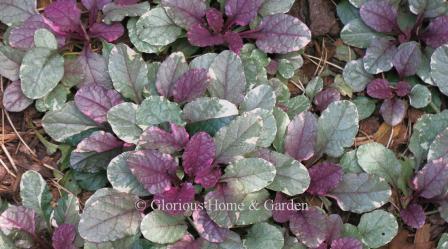 Ajuga reptans 'Burgundy Glow'
Ajuga reptans 'Burgundy Glow' Ajuga reptans 'Catlin's Giant'
Ajuga reptans 'Catlin's Giant'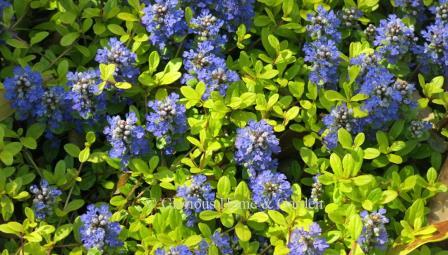 Ajuga tenorei 'Cordial Canary'
Ajuga tenorei 'Cordial Canary'Arctostaphylos uva-ursi, bearberry or kinnikinnick, Zone 2-6. This one is for the northern zones. A low-growing evergreen ground cover that forms a wide spreading mat by rooting at stem nodes and about 12” high. White blueberry-like flowers appear in spring followed by bright red fruits.
 Arctostaphylos uva-ursi 'Massachusetts'
Arctostaphylos uva-ursi 'Massachusetts'Ardisia japonica, Japanese ardisia or marlberry, Zones 7-9. This makes a lovely evergreen ground cover for shady woodland areas. Flowering occurs in summer, followed by bright red fruits.
 Ardisia japonica 'Chirimen'
Ardisia japonica 'Chirimen'Erica carnea, winter heath, Zone 5-7. Winter heath is a low-growing (about 6”), but will spread to about 2,’ with evergreen needle-like leaves. Blooming in early spring, it is available in colors of white, pink, to red. Best grown in full sun in acidic soil and kept evenly moist.
 Erica carnea 'Springwood Pink'
Erica carnea 'Springwood Pink'Euonymous fortunei, wintercreeper, Zones 5-9. Wintercreeper is a small-leaved evergreen ground cover that grows to about 4-12,” and, ome varieties can be grown into small shrubs. They are grown primarily for their evergreen foliage as flowering is inconspicuous and does not develop until the plants are quite mature. Very adaptable as to light and soil conditions, and a good choice for growing on slopes. Though the species of Euonymus fortunei is invasive in many areas of the country, culivars have been produced that are much more garden-worthy. A few varieties include ‘Coloratus,’ which turns reddish-purple in the winter; ‘Moonshadow,’ which has variegated dark green leave with a central yellow splotch; and ‘Wolong Ghost,’ which has narrow dark green leaves with silver veining.
 Euonymus fortunei 'Moonshadow'
Euonymus fortunei 'Moonshadow'Euphorbia amygdaloides var. robbiae, Robb’s spurge, Zones 6-9. Robb’s spurge is a beautiful woodland ground cover with dark green evergreen foliage. It has greenish-yellow bracts in spring. However, because it spreads by underground rhizomes, it can spread quickly, so it is important to plant it where it has room to roam without overtaking its neighbors. It also self-seeds readily, but that is easily controlled by removed the flowering stems before the seeds can ripen. Grow in shady to semi-shady areas with average moisture—it is a good choice for dry woodland conditions.
 Euphorbia amygdaloides var. robbiae, Robb's spurge
Euphorbia amygdaloides var. robbiae, Robb's spurgeGaultheria procumbens, wintergreen, Zones 3-6. A charming evergreen ground cover for shady woodland situations with good drainage. The leaves, which smell of wintergreen when crushed, hence the commons name, turn red in fall and make a good foil for the red berries which remain until spring.
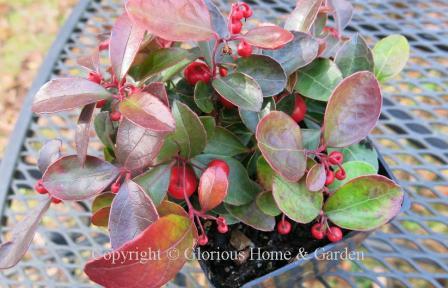 Gaultheria procumbens, wintergreen
Gaultheria procumbens, wintergreenHedera helix, English ivy, Zones 4-9. English ivy is one ground cover that will tolerate heavy shade--but beware, it can become invasive and climb into the tops of tall trees where it will block out sunlight. English ivy does produce flowers and then berries, but they are seldom seen because they occur when the vine matures and reaches high up in the trees. There are hundreds of varieties available of all sorts—large and small-leaved, dark green and variegated, hardy and non-hardy kinds used for house plants.
 Hedera helix, English ivy
Hedera helix, English ivyHelleborus orientalis, hellebore or Lenten rose, Zones 4-9. The thick, leathery leaves are attractive all year and make a beautiful companion for camellias, rhododendrons, azaleas and other part-shade loving plants. Many lovely cultivars have been bred for interesting flower patterns and colors including white, pink, red, purple, near black, even yellow and orange. Look for some of the new cultivars with beautiful mottled leaves such as H. x iburgensis ‘Dorothy’s Dawn.’
 Helleborus orientalis
Helleborus orientalis Helleborus x iburgensis 'Dorothy's Dawn'
Helleborus x iburgensis 'Dorothy's Dawn'Iberis sempervirens, candytuft, Zone 4-8. Candytuft is a low-growing, mounding sub-shrub that grows to about 8-12,” and produces masses of showy blooms in white (there are some pink varieties), over a long period in spring. Plant in full sun en masse for a lovely display. As sub-shrubs, the plants do get woody at the base, and benefit from a sharp pruning when the stems become elongated.
 Iberis sempervirens 'Purity'
Iberis sempervirens 'Purity'Juniperus conferta, shore juniper, Zone 6-9. Shore juniper is a low-growing spreading evergreen to about 10-16” h. making it an excellent ground cover for a sunny area. It is salt-tolerant, and grows well in sandy soil, so is excellent for seashore locations as the name indicates. But it is not limited to those areas as it does very well inland in a sunny, well-drained location.. Some good cultivars are ‘Blue Pacific,’ ‘Emerald Sea,’ and ‘Silver Mist.’
 Juniperus conferta 'Blue Pacific'
Juniperus conferta 'Blue Pacific' Juniperus conferta 'Emerald Sea'
Juniperus conferta 'Emerald Sea'Juniperus horizontalis, creeping juniper or carpet juniper, Zone 4-9. Creeping juniper is a very popular ground cover evergreen because it is adaptable to many conditions of soil from sandy to heavy clay, to rocky, and tolerates hot, dry conditions well. It has many uses in the landscape from mass plantings, difficult slopes, and accents. A well-grown specimen is beautiful with its gray-green or blue-green foliage and soft appearance.
 Juniperus horizontalis
Juniperus horizontalisLiriope muscari, blue lily-turf, Zones 6-9. Used extensively in the South as a ground cover
and as an edging plant for beds, liriope forms thick clumps that help keep out
grass and weeds. Purple flower spikes
emerge in summer followed by black berries.
They are typically mown over in late winter or early spring to remove the tattered old leaves before the
new growth appears. There are gold or white variegated varieties and white flowered cultivars as well.
 Liriope muscari 'Variegata'
Liriope muscari 'Variegata'Mitchella repens, partridgeberry, Zone 3-9. Looking for something special for your shady woodland garden? Partridgeberry might be just the thing. This plant, native to eastern Canada and the United States, is about the lowest evergreen ground cover around, growing about 2” high. It has small white fragrant flowers in late spring followed by red berries in fall. Grow partridgeberry in a shady location in rich, moist, well-drained soil enriched with humus, and mulched with leaf mold
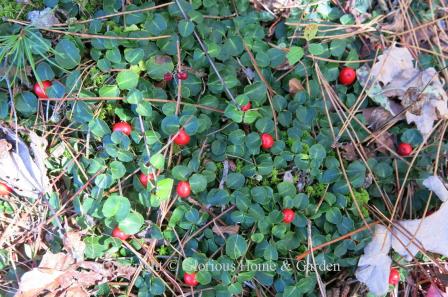 Mitchella repens, partridgeberry
Mitchella repens, partridgeberryOphiopogon japonicus, dwarf mondo grass, Zones 6-9. Dwarf
mondo grass is a very useful evergreen ground cover. It can be used to
mimic a turf lawn for an expanse of green, as an edging for a border or to
soften stones along the edge of a stream.
Of course, they are an important element of Japanese gardens. It is
happy in sun or partial shade and needs little care other than a mowing in late
winter or early spring before the fresh, new leaves emerge. Mondo grass differs from monkey grass (Liriope)
by its shorter height, narrower leaves, flowers which tend to hide among the
blades, and blue rather than black berries.
There are some very dwarf varieties of about 2-4” high, such as ‘Nippon, and a very dark, nearly black one called
‘Nigrescens.’
 Ophiopogon japonicus
Ophiopogon japonicusPachysandra terminalis, Japanese pachysandra or spurge, Zone 4-9. Pachysandra is a attractive ornamental evergreen ground cover for a shady woodland with tooth-edged leaves and white flowers in spring. Even though it spreads rather quickly via rhizomatous roots, I would much rather have it than English ivy if I needed a shady ground cover--at least it doesn't climb trees!
 Pachysandra terminalis
Pachysandra terminalisRubus pentalobus, creeping raspberry, Zone 7-9. Creeping raspberry is an attractive evergreen ground cover with small, heavily textured leaves and prickly creeping stems that will cover an area enthusiastically. Grow in partially sunny to partially shady conditions--but don’t expect spectacular flowers or lots of fruit. However, it does turn a beautiful raspberry-red color in the fall. Also known as R. calycinoides.
 Rubus pentalobus, creeping raspberry
Rubus pentalobus, creeping raspberrySelaginella braunii, arborvitae fern, Zones 6-9. Arborvitae fern is not a fern, but a spikemoss, a fern relative. It is a most attractive ground cover for a shade garden.
 Selaginella braunii, arborvitae fern
Selaginella braunii, arborvitae fernSelaginella uncinata, peacock spikemoss, Zones 7-9. So-called peacock moss, is not a moss, just like the arborvitae fern above is not really a fern. Can we just get used to calling them spikemosses? Good for woodsy, filtered sunlight situations where it will form a dense mat of metallic blue-green foliage, 2-4” high.
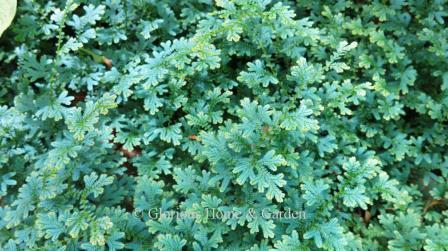 Selaginella uncinata, peacock moss
Selaginella uncinata, peacock mossThymus serpyllum, creeping or wild thyme, Zone 5-8. Creeping thyme makes a beautiful ground cover for a full sun location with good drainage. It is a woody evergreen sub-shrub with aromatic foliage that grows about 3” high and spreads to about 12”. Varieties are available in shades of red, pink, lavender or white and are lovely used to edge a path, on slopes, or between stepping stones to release the fragrance as you walk by. Varieties include ‘Albus,’ white; ‘Coccineus,’ red; ‘Pink Chintz,’ pink; and there are even variegated ones such as ‘Hartington Silver’ (or ‘Variegatus’) with green and cream foliage and pale pink flowers.
 Thymus serpyllum 'Albus,' creeping thyme
Thymus serpyllum 'Albus,' creeping thymeTrachelospermum asiaticum, Asiatic star jasmine, Zones 7-9. Asiatic star jasmine is an easy-to-grow evergreen vining ground cover or shrub that thrives in partial shade. Dark green leaves contrast beautifully with small, creamy white fragrant star-shaped flowers in spring. Though the species can grow to 15’ or more, the newer cultivars are closer to 2 or 3’ and are easily maintained. A couple of particularly pretty cultivars are ‘Chirimen’ with narrow dark green leaves with silver veining, and ‘Snow-N-Summer™’ with tri-colored leaves of pink new growth and white, and green variegation. Deer resistant, too!
 Trachelospermum asiaticum 'Chirimen'
Trachelospermum asiaticum 'Chirimen' Trachelospermum asiaticum 'Snow-N-Summer™'
Trachelospermum asiaticum 'Snow-N-Summer™'Vinca major, large periwinkle, Zone 7-9. Vinca major is a trailing evergreen vine with larger leaves and blue flowers similar to V. minor, but larger. Nice to grow on slopes in a moist, partially shaded area. Cultivars are available in white, blue, and purple.
 Vinca major
Vinca majorVinca minor, common periwinkle, Zone 4-9. Vinca minor is an attractive, low-growing evergreen ground cover that trails the ground, rooting at stem nodes as it goes. Vinca minor is hardier than V. major, and is smaller in all its parts. It flowers in spring in colors of blue, white, or purple. ‘Ralph Shugert’ is an attractive cultivar with variegated leaves and blue flowers.
 Vinca minor
Vinca minor Vinca minor 'Ralph Shugert'
Vinca minor 'Ralph Shugert'Plant of the Month

Ilex verticillata
Winterberry holly
Updated new USDA Plant Hardiness Zone Map 2023.